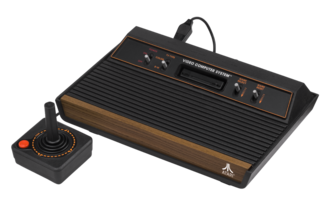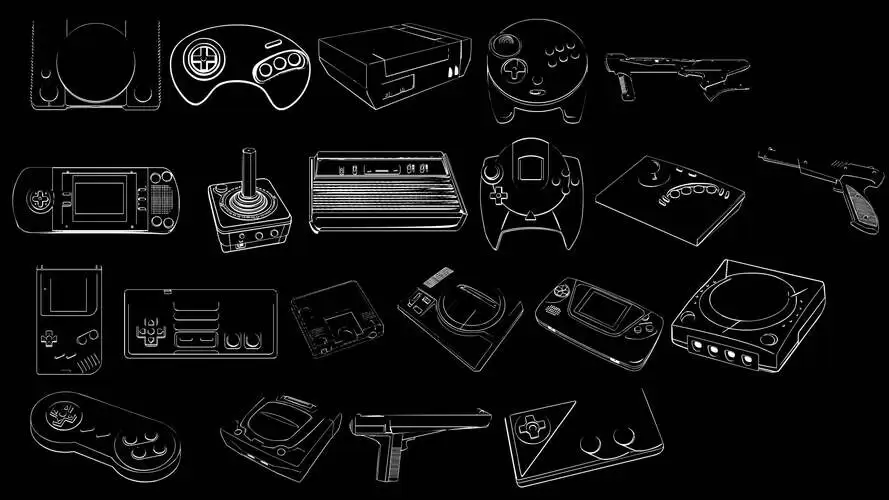

THE FIRST EASTER EGG IN VIDEOGAMES
"ATARI VCS AND WARREN ROBINETT’S ADVENTURE"
Related Stories
Cutting to the chase, we will attempt to paint the whole picture about how the first easter egg in video games came to be, the one in Atari’s Adventure of 1979. Was it just an artistic expression or a message in a bottle from its developer, Warren Robinett? So, let’s commence;

VIDEO GAMES!!!
The alpha of commercial coin-up video games was the black-and-white table tennis game called Pong. It was released in 1972 by Atari and it played an essential role in the genesis of a new industry; the video game industry!!! At the same time, at Rice University of Houston, a young man named Warren Robinett was studying Computer Applications in Language and Art. He would graduate in 1974, the same year that Atari’s financial problems would lead to a merging with Kee Games.
A year later, Warren was working as a Fortran programmer for the oil exploration company Western Geophysical. Meanwhile Atari, on Christmas of that year, would release a multi-colored home version of Pong for $98,95 as a Sears department store exclusive. Even though it was a single game machine, it was a colossal success, and here’s why: In 1975, 68 million households in North America had a television set -or the now commonly called TV, and 30% of those were black-and-white monochrome displays.
Black-and-white or colored, it was the one and only “multimedia entertainment device” for the home. At that time TV prices were roughly starting from $300 (equivalent to around $1,250 in 2020), while most of the video games were color monochromatic or black-and-white monochromatic. Meanwhile, Warren would continue his studies at the University of California, in order to take his Master Associate Degree in Computer Science in 1976.
But what all these have to do with the first easter egg? Well, keep reading!

THE ADVENT OF WARNER COMMUNICATIONS
1976 was the same year that Atari was completing the development of its next innovation in the video game industry, the Atari VCS. At the time, the company found itself in a deep need for investors. In order to cover its high production and marketing costs, Warner Communications, the American media, and entertainment company -which at that time was the parent company of DC Comics, Warner Bros., Warner Music Group, Warner Cable, and Dimension Pictures, was extremely interested in the home video game consoles and video game selling business. Atari was finally bought the same year for around $30 million by Warner Communications.
But a year later, on September 11, something happened that would change the home entertainment game.
THE VIDEO COMPUTER SYSTEM
On September 11 of 1977, Atari released one of the first cartridge-based home video game consoles. In contrast to the first home video game console, 1972’s Magnavox Odyssey, which was a seminal invention, but soundless with black-n-white monochromatic display capabilities nonetheless, Atari’s one could reproduce sound and multicolored graphics, up to 128 on-screen colors.
It was named Atari Video Computer System or Atari VCS in short (which later got rebranded to the Atari 2600) and launched bundled with the game Combat, two joysticks, and a set of paddle controllers at $199 (equivalent to less than $850 in 2020’s money). Plus, it’s worth mentioning that there were eight more games and many peripherals available for purchase. Much like the game consoles of today, in order to establish a huge customer base, it was sold at cost and all the profit was expected to be gained through games and peripherals’ sales.

ATARI: MAKE GAMES, NOT WAR-NER :D
Robinett started working for Atari in 1977. He was Atari’s first employee with a Computer Science degree. Every other programmer in Atari had an electrical engineering background. From its founding, Atari’s programmers were left to their own devices and there was no dress code nor working hours for them. The company was based in California, the Arcadia of hippie culture, even for corporate environments. That laissez-faire stress-free working regime was beneficial for the creativity needed for the programmer staff, which was usually free to choose over what game would work on. And that regime was uncontrollable by the thin corporate infrastructure of Atari. Before it became Warner’s daughter company, it had no Human Resources Department and there was no chief financial or manufacturing officer whatsoever. Afterward, Warner brought new hires to fill those positions -and even more ones.
But from marketing to managerial all the new staff, none of them had any background in computer engineering or video games. In contrast to the two electrical engineers that were the original founders of Atari, Nolan Bushnell and Ted Dabney, the new CEO, Ray Cassar was a strict businessman with an MBA degree from Harvard with zero relation to computer technology or video games at all. He was previously working in the textile industry and he brought among business staff in Atari, in order to control and discipline the rebellious part of the creative chaos that existed -especially in the programming department.
ATARI VCS: THE TECH
Atari started with a 4-people programming team and by the time that Warren was hired, that team was double in size. Games at Atari were made solely by one person who would design, program, create the sounds/graphics, and would be in charge of game testing and debugging. The first batch of Atari VCS’s games run from a ROM cartridge of 2 KB (kilobytes) of memory and later games would run from a 4 KB one. That tiny amount of memory, plus 128 bytes of RAM, was available to the programmers for the game’s code and graphics.
Those tech specs were low, even for that era, but it was the only way for the Atari to keep the manufacturing cost as low as possible. Additionally, all the sounds needed to be programmed through the game’s code. Specific commands would trigger audio frequencies of the console’s sound generator producing white noise, sine wave, and triangle wave sounds of chiptune texture.

ATARI VCS: THE DEV TOOLS
At that time there was no graphic editor for the Atari VCS. Every programmer would use pencil and graph paper to design the graphics and then convert them to graphics by typing code into his development kit. Fortunately for optimal performance, any code was written directly in assembly language for the MOS 6507 CPU of the Atari VCS. The development kit was actually cutting-edge tech and was consisted of a special fridge-sized terminal/microcomputer equipped with an 8” floppy drive, a printer that gave the ability to print out the code and check it more easily and thoroughly, and a Hewlett-Packard 1611A (a logic state analyzer) for debugging.
Each programmer had the ability to run and test his code directly from the terminal on the Atari VCS, via a cable that was connected to a special 8 KB cartridge with rewritable memory (RAM), that would plug in the Atari VCS’s cartridge port. That technology allowed any code changes to be tested almost instantly.
SLOT RACERS AND BEYOND
Warren’s first game was Slot Racers, a 2 KB game for the Atari VCS that got released in 1978. Amidst the development of Slot Racers, he had already started to explore ideas for his next game. At some point, Warren was invited to play a computer game at Stanford Artificial Intelligence Laboratory by a friend who was working there. He then experienced one of the most fantastic games; Crowther and Woods' Colossal Cave Adventure, aka Colossal Cave aka ADVENT. It was a game that needed at least 100 KB of memory to run.
It was originally developed and run on M.I.T.’s PDP-10, a computer mainframe, a series of fridge-sized computer machines with equally-sized peripherals and modules, that were connected together and had hundreds KB of memory -at least a couple of dozen of times the memory of an Atari VCS 4 KB cartridge. Colossal Cave was the first one in the genre of text-adventure, which is now called ‘interactive fiction’.

THAT ADVENTURE GAME
Text-adventure is a type of game where everything is expressed solely through text. Every player’s action is entered by text and every game’s response is text and Colossal Cave was about spelunking in a heavily inspired by the pen-and-paper RPG, Dungeon and Dragons. Bedazzled by that unexpected magical experience, Warren decided that his next game would be a graphic adaptation of that game.
So, he informed his immediate boss George Simcock about his next creation. But Warren’s immediate boss, Simcock, knew all about the memory requirements of 100 KB that Colossal Cave had in order to run, as well as the memory restrictions of the Atari VCS’s 4 KB cartridges, and deemed to be “impossible for anyone” to create a graphical version of it and suggested not do it. Warren, who by his own words “did not like to be told what to do'' -even by his immediate boss, in order to prove to him that it was feasible to do, secretly created a prototype in just a month.

THAT IMPOSSIBLE GAME
Any video games at that time, such as Pong or Asteroids, were taking place in a single screen. Warren’s prototype game presented a world that was extending beyond one screen. More detailed, it had six different ones. The avatar of the player was represented by a square, which was able to travel in any direction from one screen to another, just by moving the joystick’s lever. The player could also pick up objects by placing the avatar over them and drop them by pressing the joystick’s button. The prototype had two objects and a single enemy, a dragon. That prototype was analogous to a playable demo or a vertical slice of today.
After completing it, Warren took a month of vacation. During that period, his co-workers were starting to play his prototype game and, after a while, it became quite a hit around the office. Surprisingly, it was not approved by his boss, but from the Marketing division, which took notice of the excitement from the programming staff.

ROBINETT VS SUPERMAN
When he returned from his vacation, he continued the secret development of his game. The following months, and during many meetings with the Marketing division, Warren would be told to convert his game to a superman one, in order to accompany the first Superman movie that would be theatrically released the same year by Warner Bros. Warren of course did not want to do anything with that and, in one of those meetings, John Donne, a fellow programmer of his, volunteered to take what code existed so far of his game, and create the superman one, allowing Warren to secretly continue with the development of his graphical adventure game.
In 1978, and while he had already devoted a year creating his game, he was officially working on a non-game release, an educational cartridge named “BASIC Programming”, that taught the very fundamentals of the programming language BASIC that would get released in 1979.
That same year, the superman game that had his code in it was released. At that time, he finally completed his game and handed the game’s code to his boss, Simcock, in order to get the game into production. But instead of kudos, Warren was treated like a bad employee. So soon after that, he quit.
WARREN WAS HERE
It was the same year that a brand new game called “Adventure” would sell 1 million copies. And yes, you’ve guessed right: it was Warren’s game. It took three years from inception to release. Warren had created a new game genre, the graphical action-adventure. It had a huge 30-rooms-Gameworld that the player could explore, where he could also find and use magic items and weapons, in order to get the magical chalice and return it to the golden castle. Atari’s programmers, much like Warren when he was hired, had been promised royalties of 10 cents of every cartridge sold, but unfortunately, no one got anything ever.
Atari was keeping its game creators anonymous, so they couldn’t claim royalties or find better job opportunities. The original four-people programming team of Atari knew that and, after an intense meeting with the company’s CEO, Ray Kassar, about royalties, they left Atari and created Activision in 1979. Activision is the first independent, third-party developer in console video game history.
So, how did Atari's policy affect the creation of the first easter egg in video games?
THE FIRST EASTER EGG
Warren, being aware of Ray Cassar’s power plays, decided to “sign” or tag -like a graffiti artist- his name in a hidden room inside Adventure. He wrote a message that was the most colorful thing in it, with flashy polychromatic letters that would read “Created by Warren Robinett''. It was the first easter-egg in video games! It was discovered a year after its release by a player and became quite a trend among programmers to hide their names or initials ever since.
By that time, he had already found along with three educators, Ann McCormick Piestrup, Leslie Grimm, and Teri Perl, the first and very successful educational software company, The Learning Company.
More information is available at this GDC talk from Warren Robinett himself here.
And if you’re still left wanting more, you can visit Warren Robinett’s official page.
Ⓧ
Related Consoles





